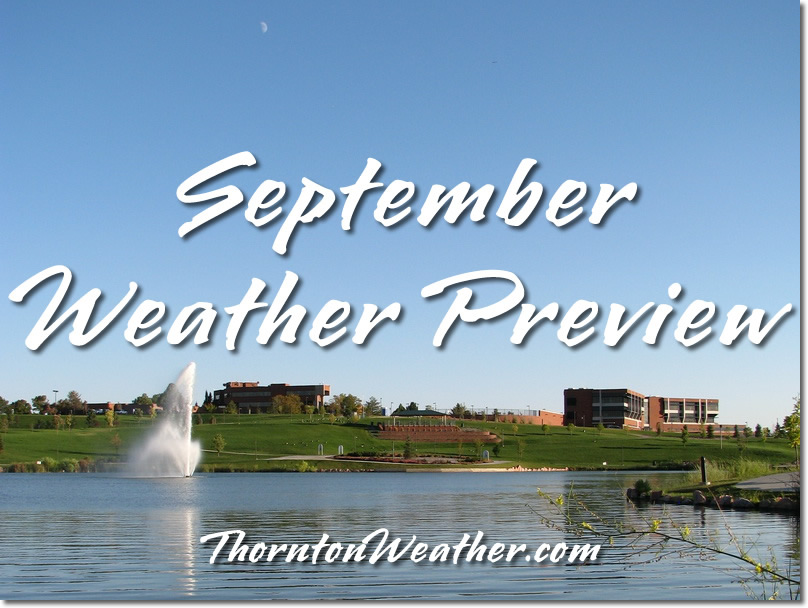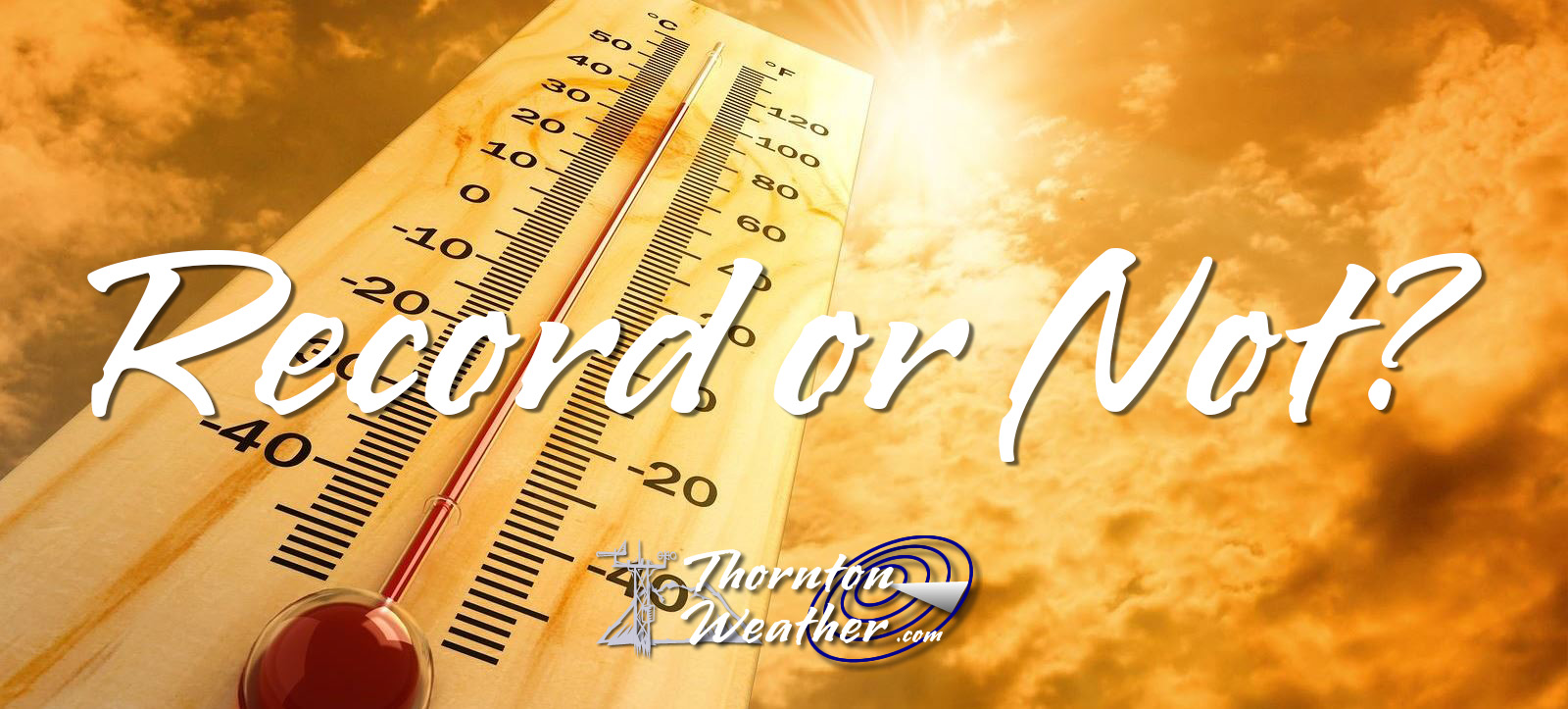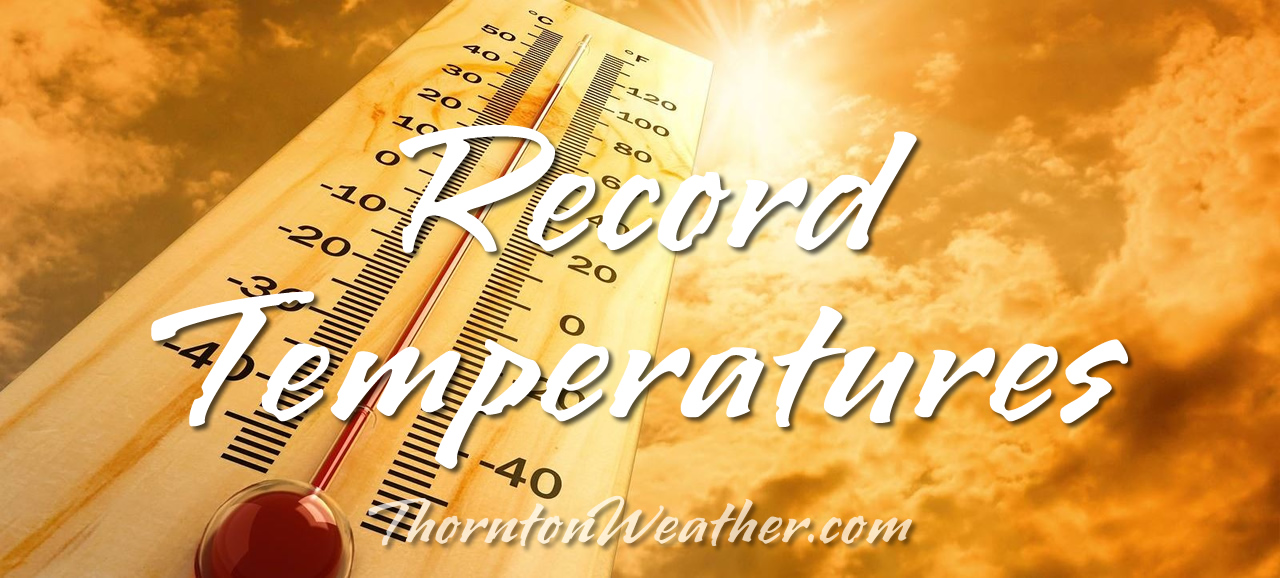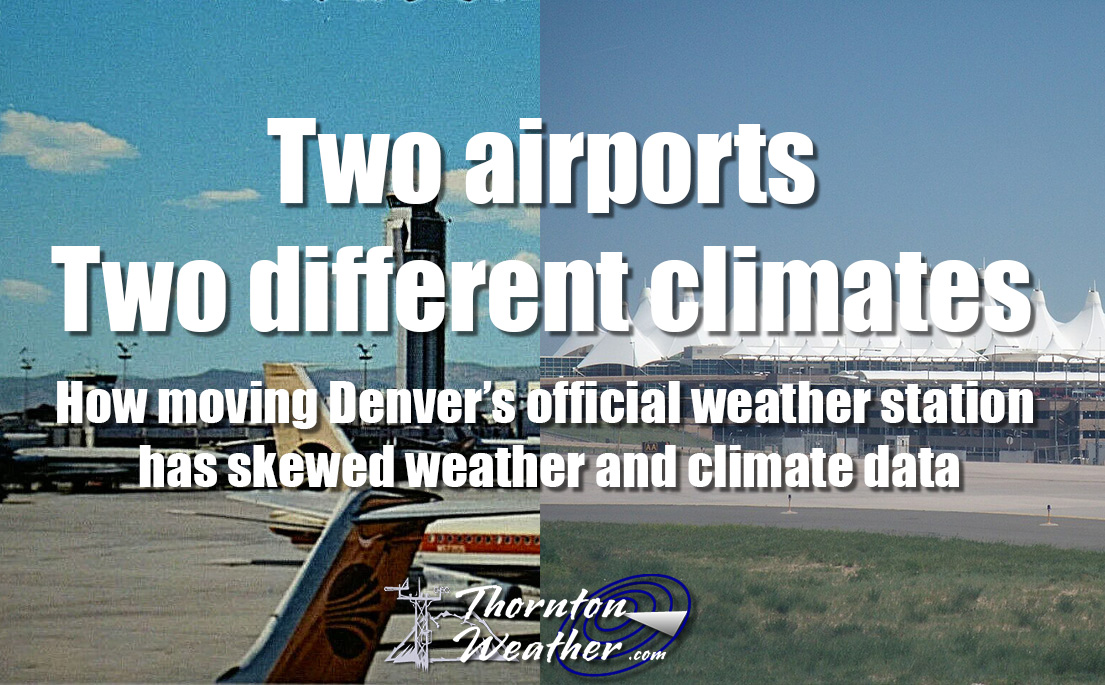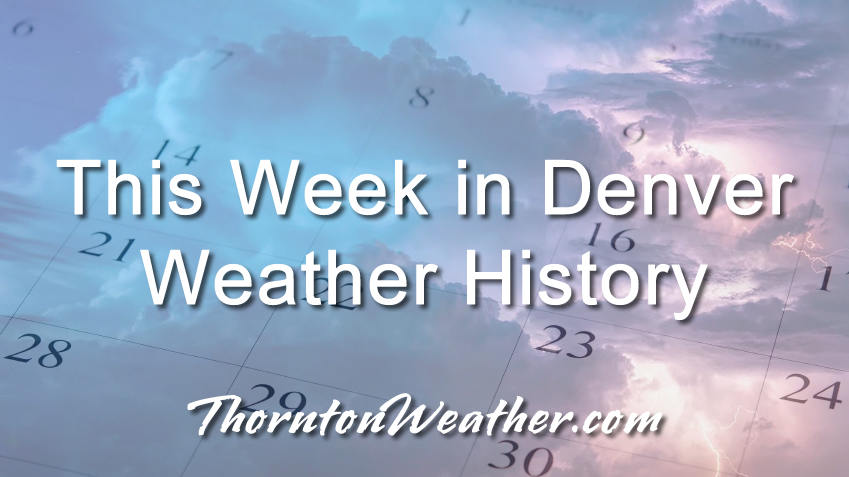
September usually means the end to the dog days of summer and oftentimes is one of our most pleasant months. Our look back at this week in Denver weather history shows that isn’t always the case however as we have seen flooding rains, hail, powerful winds and even the earliest snowfall on record in the Mile High City.
From the National Weather Service:
1
In 1951…large hail pounded Boulder…causing thousands of dollars in damage to roofs and automobiles. Heavy thunderstorm rainfall flooded basements and produced widespread street flooding.
In 1966…severe thunderstorms caused local flooding in areas from Denver to the north and east. There was scattered damage from hail and lightning. Streets were flooded in Boulder…and streets and basements were flooded in several areas of metro Denver. The public reported 1 inch diameter hail in Aurora and near Cherry Creek Reservoir. Thunderstorm rainfall totaled only 0.39 inch at Stapleton International Airport.
In 1985…severe thunderstorms dumped heavy rain and hail at many locations along the Front Range from Denver south. The southern and eastern suburbs of metro Denver were especially hard hit. Rainfall from 1 1/2 to 3 inches caused extensive street flooding in Aurora where two creeks rose out of their banks. Two homes in the city suffered minor lightning damage. Almost 4 inches of rain fell in the Parker area. Hail up to ping-pong ball size piled up to a foot deep and closed a road in Evergreen. Hail as large as 1 3/4 inches in diameter was reported 8 miles northeast of Deckers. Wind gusts to 65 mph were estimated in southeast Aurora.
In 1990…marble size hail piled up to 2 inches deep in the foothills community of Kittredge…18 miles southwest of Denver. As much as half an inch of rain fell in just 15 minutes and caused minor road and small stream flooding. A thunderstorm dropped pea to marble size hail and brief heavy rain near Ward Road and 64th Avenue in Arvada. Minor street and small stream flooding was reported in the area.
In 1995…a strong thunderstorm microburst with only a few drops of rain produced a recorded wind gust to 85 mph at the site of the former Stapleton International Airport. The wind gust occurred at 8:30 pm MDT. The all-time highest recorded temperature in September…97 degrees… Occurred. The same temperature also occurred on September 5…1899…September 4…1960…and September 4… 1995.
In 2019…the high temperature in Denver reached 98 degrees… which not only broke the record for the date…but also set a new monthly record for the month of September.
1-5
In 1995…record breaking heat occurred on the first 5 days of the month when the temperature climbed into the 90’s on each day. Record high temperatures of 97 degrees on both the 1st and 4th equaled the all-time record maximum for the month. High temperature of 95 degrees on the 3rd was a record for the date. High temperatures of 94 degrees on both the 2nd and the 5th were not records. The low temperature of 64 degrees on the 4th equaled the record high minimum for the date.
1-7
In 1978…the temperature reached 90 degrees or more on seven consecutive days with the highest temperature…94 degrees… Recorded on both the 4th and 6th.
1-30
In 2020…a worsening drought that started in the spring and continued through September. Outside of an early season snow on the 8th…the month of September was another unseasonably warm and dry period. The combination of hot…mostly dry conditions…and critically dry fuels… resulted in a continuation and rapid expansion of several massive wildfires. The Cameron Peak fire…which became the largest in the state`s history started on August 13th…and continued through September. As a result…very poor air quality continued to impact Denver and the entire Front Range. Denver recorded the most days ever with a high temperature of 90 degrees or better; 75 days. The last of which was 91 degrees on the 24th. The previous record was 73 days set in 2012.
2
In 1938…heavy cloudbursts in the foothills near the top of Genesee mountain caused flash flooding on Bear Creek at Morrison. Nearly 8 inches of rain fell just north of Morrison in 6 hours and drowned 6 people in a car between Morrison and Kittredge. Damage was estimated at nearly a half million dollars. Flash flooding also occurred on south Boulder Creek in Eldorado Springs. Rainfall totaled 4.42 inches in Eldorado Springs…and rainfall was estimated to more than 6 inches in the foothills west of the town. Many buildings and residences were damaged in Eldorado Springs…and bridges were swept away. The high waters forced residents from their homes as far downstream as Erie. This was the flood of record on south Boulder creek.
In 1973…hail to 3/4 inch diameter was reported in Boulder.
In 1987…lightning struck two men who were standing under a tree in downtown Denver. Both were seriously injured and hospitalized.
In 1996…lightning sparked a brush fire in the south buffer zone of the Rocky Flats Environmental Test Facility. No structures were damaged…but the fire burned about 100 acres of grassland before being contained.
In 2019…the record high temperature of 100 degrees was set in Denver…shattering the previous daily record of 95 established in 1983. Not only was the daily record set… it also set the all time monthly record for September. The previous record for the month was 98 degrees…which was set the previous day. In addition…it was the latest 100+ degree day ever reached during the calendar year in Denver`s climate record…breaking the previous mark by 17 days. The previous record occurred on August 16th…2002. Lastly…it was the hottest Labor Day on record.
2-3
In 1892…there was a trace of rainfall each day. This… Together with a trace of rain on both the 7th and 8th…was the only rainfall of the month…making the month the driest on record. The monthly record was equaled in 1944.
3
In 1901…a thunderstorm produced rain…hail of unknown size… And south winds sustained to 40 mph with gusts to 43 mph.
In 1961…Labor Day snow storm is the earliest date of the first snow…trace and measurable…of the season. The heavy wet snow broke many limbs from trees that were still in full foliage. The storm produced 4.2 inches of snowfall at Stapleton Airport with nearly a foot of snow in western suburbs and in the foothills. Minimum temperature of 33 degrees was a record for the date and the coldest ever recorded so early in the season.
In 1999…severe thunderstorms dumped large hail across metro Denver. Hail as large as 1 inch in diameter was measured near Cherry Creek in Aurora and near Bennett. Hail to 3/4 inch in diameter fell in the city of Denver.
In 2002…a thunderstorm produced a wind gust to 51 mph at Denver International Airport.
In 2003…very heavy thunderstorm rain washed out parts of the Virginia Canyon Road above Idaho Springs. Up to 4 feet of mud reportedly washed down the road during the storm. Several vehicles were trapped on the road.
In Idaho Springs…several streets…including the main street… Were also buried in mud and gravel. Some buildings in town experienced minor flooding…including the basement of the town library and the police station.
3-6
In 1909…rainfall for the 4 days accumulated to 3.97 inches in Boulder…while in Denver rainfall totaled 2.45 inches on the 4th…5th…and 6th.
4
In 1909…apparent post-frontal heavy rainfall totaled 1.94 inches in downtown Denver. North winds were sustained to 19 mph.
In 1944…a trace of rain fell. This together with a trace of rain on the 9th…10th…and 30th was the only precipitation for the month. The total of a trace of precipitation for the month equaled the driest September on record first set in 1892.
In 1960…the highest recorded temperature in September…97 degrees…occurred. The same temperature also occurred on September 5…1899…September 1…1995…and September 4… 1995.
In 1989…a strong thunderstorm wind gust flipped a plane taxiing on a private runway in Adams County east of Denver. Two people were slightly injured and the plane was heavily damaged.
In 1992…strong winds developed across metro Denver behind a pacific cold front. Sustained winds above 40 mph with gusts as high as 60 mph were recorded mainly in and near the foothills. Pre-frontal south winds gusted to 37 mph at Stapleton International Airport.
In 1995…two people were injured when lightning struck their home in Lakewood. The lightning entered the attic where it started a small fire. It then traveled through the walls… Exploding a mirror and spraying glass on the residents. Lightning also sparked small grass fires near Aurora…Denver International Airport…and Bennett. The highest recorded temperature in September…97 degrees…occurred. The same temperature also occurred on September 5…1899…September 4…1960…and September 1…1995.
In 2000…thunderstorm winds gusted to 64 mph in Castle Rock.
5
In 1899…the highest recorded temperature in September…97 degrees…occurred. The same temperature was also reached on September 4…1960…and September 1 and 4…1995.
In 1940…a severe wind and hail storm confined mostly to the west and north parts of the city occurred shortly after 4:30 pm. Hail stones ranged in size from 1/4 to 1/2 inch in diameter.
In north Denver…hail piled to a depth of 4 inches. Flooding occurred in one underpass…which stalled 2 cars. One girl was injured when the weight of the hail flattened a porch on which she stood. Northeast winds were sustained to 29 mph with gusts to 32 mph in downtown Denver.
In 1987…a thunderstorm complex produced hail as large as 1 3/8 inches in diameter…2 miles east of Buckley Field in Aurora. No damage was reported.
5-8
In 2020…a strong upper level low brought an end to record heat to the Front Range urban corridor…and provided Denver its second earliest measurable snowfall on record. Numerous heat records were set leading up to the snowfall…and several new snowfall and cold records were also broken in this abrupt bout with winter. Denver set its all time record high for September…reaching 101 degrees during the afternoon. This was also the latest date a 100 degree reading has ever been observed in Denver. Another daily record high was then tied on September 6th when Denver hit 97 degrees. September 7th was the last day of heat when Denver`s high temperature reached 93 degrees. That tied Denver for the record for the number of 90 degree days for a year at 73…and was also the warmest temperature ever recorded before a day of measurable snowfall. By the evening of September 7th…a series of cold fronts progressed southward from Wyoming into Colorado… dropping the temperature into the low 30s by the early morning hours of September 8th. Snow developed across the Front Range mountains and foothills overnight… while a mix of rain and snow developed along the I-25 corridor. A few locations picked up light snowfall accumulations in the morning. Accumulating snow was mostly confined to the higher elevations much of the day…before spreading across the plains during the late afternoon and evening. Storm totals ranged from 4 to 10 inches in the mountains…with 3 to 6 inches near the foothills. A total of 5.6 inches of snow was measured at the NWS Boulder office…while at Denver International Airport…the official measurement was 1.0 inch.
5-9
In 1988…layers of smoke aloft from large forest fires in Yellowstone National Park completely obliterated the sun at times. At Stapleton International Airport…surface visibility was reduced at times to 5 and 6 miles in smoke.
5-13
In 2010…the Fourmile Canyon wildfire…northwest of Boulder… Broke out on the morning of the 5th. It originated from an unattended fire pit at a local residence. The wildfire quickly consumed 5 1/2 square miles or 3500 acres the first day…and forced the evacuation of over three thousand residents. Erratic 45-mph gusts sent the fire in two directions at times. Very dry weather conditions preceded the fire. The combination of strong winds…low relative humidities and dry fuels allowed the wildfire spread rapidly through the steep…heavily forested terrain. The flames were reportedly 20 to 50 feet in length. Towns within the burn area included Salina…Wallstreet and Gold Hill. The dry conditions coupled with gusty winds ranging from 45 to 64 mph persisted for several more days. Fire managers used as many as 700 firefighters and support personnel from 35 agencies and seven air tankers to battle the wildfire. A total of 6181 square acres or approximately 10 square miles were burned. The Fourmile Canyon wildfire was the most destructive fire in Colorado history in terms of the damage to personal property. It destroyed 171 homes with an estimated cost of 217 million dollars.
6
In 1940…a thunderstorm pelted the city with small hail. The storm produced some lightning damage. One woman was stunned by a bolt which struck near her. Heavy rain from the storm raised the level of Cherry Creek by more than 3 feet during the height of the storm. Rainfall downtown was only 0.26 inch.
In 1988…strong winds blew down two houses that were under construction in Castle Rock. Northwest winds gusted to 44 mph at Stapleton International Airport.
In 1993…a man was struck and killed by lightning while standing outside his home in unincorporated Arapahoe County 11 miles south of Denver. Lightning also struck a cabin in Marshdale…20 miles southwest of Denver…which started a fire and damaged one room and a portion of the roof.
In 1995…hail as large as 3/4 inch in diameter fell in Coal Creek Canyon in northern Jefferson County.
In 2001…a thunderstorm dropped 3/4 inch diameter hail in Aurora near Cherry Creek.
7
In 1875…the creeks were running dangerously high during the night from heavy rains in the mountains.
In 1885…a thunderstorm produced very white hail of irregular shape and about the size of beans. Precipitation was only 0.10 inch.
In 1971…a vigorous cold front accompanied by a thunderstorm produced wind gusts to 48 mph at Stapleton International Airport and much upslope cloudiness and light rain across metro Denver.
In 1989…widespread thunderstorms produced lightning strikes that knocked out power to about 13 thousand homes in Boulder County.
In a rugged area stripped of vegetation by a forest fire earlier in July…heavy rain triggered mud slides that destroyed one home and severely damaged another in Boulder canyon 10 miles west of Boulder.
In one home…the mud caved in an exterior wall and poured into the residence only seconds after 2 people had evacuated the premises. Rainfall totaled 1 to 3 inches. Hail 1 3/4 inches in diameter fell in Nederland…Idaho Springs…and Golden Gate Canyon. Hail 1 inch in diameter was measured 10 miles north of Golden.
In 1993…thunderstorm winds toppled an overhead sign onto the intersection of I-70 and I-25 in Denver…causing considerable damage to 4 vehicles. The winds also caused a police car to be blown off the road northeast of Denver. Thunderstorm winds gusting to 66 mph damaged the siding of a residence southeast of Brighton. A thunderstorm wind gust to 53 mph was recorded at Stapleton International Airport. Hail to 7/8 inch in diameter fell at Kittredge in the foothills of Jefferson County.
In 1994…lightning severely damaged a public television transmitter atop Squaw Mountain west of Denver.
7-8
In 1884…a windstorm from mid-afternoon until the early morning hours of the 8th produced south winds sustained to 48 mph. The strong winds toppled several trees in the city.
In 1892…there was a trace of rainfall each day. This together with a trace of rain on both the 2nd and 3rd was the only rainfall of the month…making the month the driest on record. The record was equaled in 1944.
